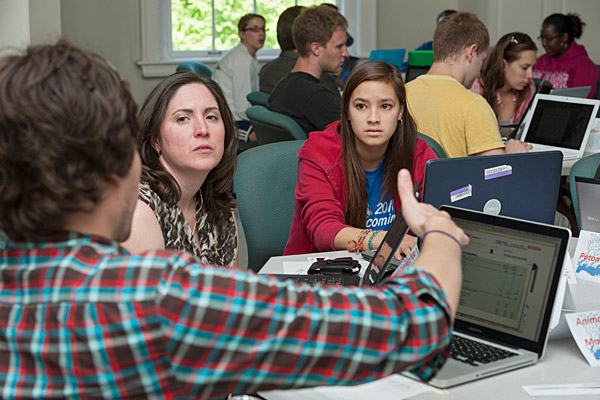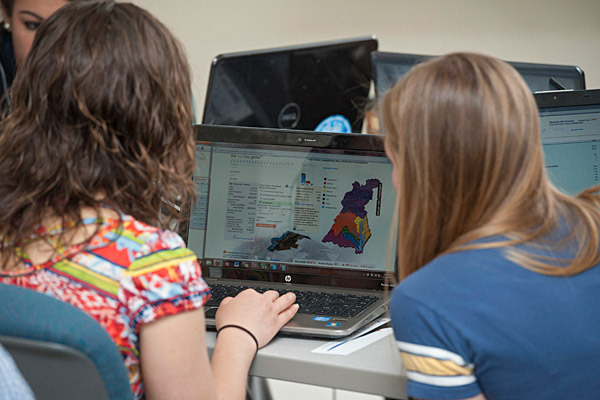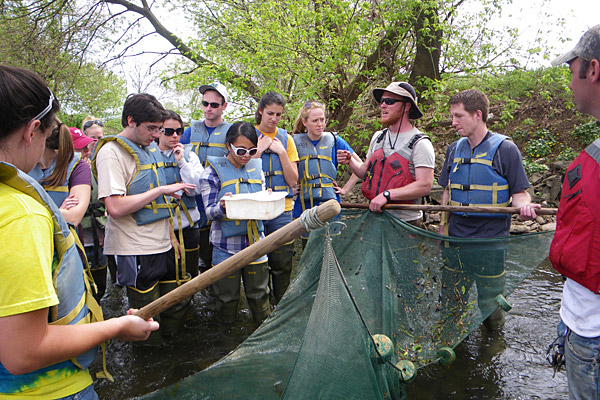

Protecting the bay
Students experience Chesapeake Bay management through eyes of stakeholders
3:29 p.m., May 24, 2012--When thinking about the many players that influence the Chesapeake Bay’s health – homeowners, farmers, developers, watermen, policy makers – it’s easy to consider them as being in competition.
A sophisticated computer game dispelled that notion for students recently as they took on those roles and tried to balance economic interests with environmental sustainability.
Campus Stories
From graduates, faculty
Doctoral hooding
“If we all don’t win, we don’t win,” said David Smith of the University of Virginia as he and colleague Jeffrey Plank facilitated the UVA Bay Game with a class of UD environmental studies and environmental science majors.
The participatory simulation game about nutrient management in the Chesapeake Bay watershed is aimed at raising awareness of environmental stewardship. The object is to balance economic activity with the health of the bay, measured by low oxygen levels from excessive nitrogen and phosphorous pollution.
Each player is assigned a stakeholder role within one of seven watersheds that feed into the Chesapeake, such as a cattle farmer in the Eastern Shore or a land use policy maker in the Susquehanna region.
Armed with laptops in a classroom in Memorial Hall, students examined information relevant to their individual roles that was pulled from real demographic, scientific and economic data.
In successive rounds representing two-year spans starting in 2000, players discussed their options with one another and made decisions about how to manage resources. A farmer might adopt organic farming practices, while a policy maker could create subsidies to influence behavior. With all choices submitted, the game crunched the numbers using thousands of differential equations.
In the first round, the students improved the bay health from the baseline of 60 percent up to 80 percent. Graphs charted nitrogen runoff, phosphorous levels, annual flow, the harvestable crab population and other environmental considerations.
On the economic side, some players made money and other didn’t. Based on those results, they adapted their choices for the next round. For example Andrew Musetto, a “bay policy maker,” increased the crab catch limit by 40,000 and allowed five more days for harvesting.
“There are a lot of crabs left, we didn’t really make much money and there is good bay health,” Musetto said. “So I’m just testing to see what happens.”
Turned out, his decisions and those of his classmates – plus a hurricane that year – caused the bay’s health to take a nosedive.
Smith and Plank stressed that while the students should act in the interests of their roles based on their own values, they may need to adapt along the way. By the end of the game, the bay’s health was nearly back up to the baseline and almost all of the players were “making money.”
“It’s really new and innovative technology for looking at the Chesapeake Bay watershed,” said student Tiffany Jones, who played as a cattle farmer. “It gives new perspective.”
The game was the final activity in a semester-long capstone course designed to engage seniors in environmental issues. Previously they took an educational canoe trip with the Chesapeake Bay Foundation and visited a Mennonite farm in Lancaster County, Pa., to learn about nutrient management in agriculture and the connection to aquatic ecosystem health.
The class also interviewed real-world stakeholders in Delaware, including a local farmer and elected county official, an environmental scientist with the Delaware Department of Natural Resources and Environmental Control, the executive director of trade association Delmarva Poultry Industry, Inc., the executive director of the free-enterprise promoting Positive Growth Alliance and a professional wetland scientist who works with developers.
“It’s very important for the students to learn the different perspectives firsthand,” said UD course instructor Luc Claessens, assistant professor of geography. “What I hope is that they get a better understanding of the complexity of the system and the linkages between their actions.”
Article and video by Teresa Messmore
Photos by Evan Krape and courtesy of Luc Claessens











